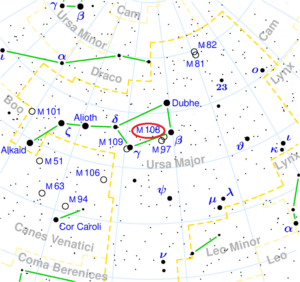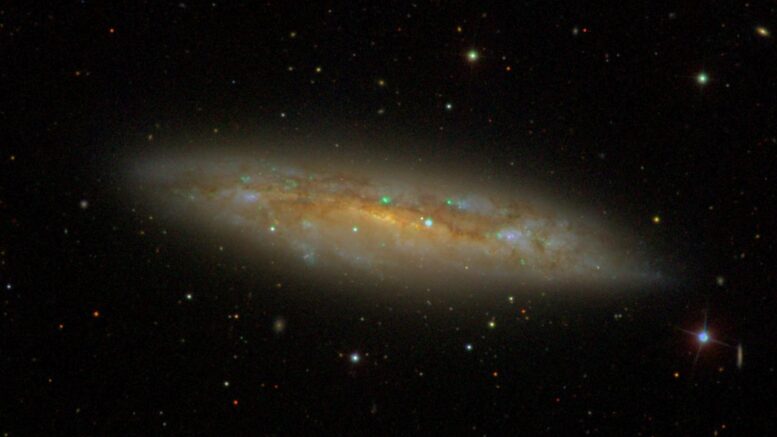Messier 108, nicknamed the Surfboard Galaxy, is a barred spiral galaxy located in the constellation Ursa Major. The galaxy is circumpolar north of latitude 35N and can be seen throughout the year in the Pacific Northwest. Messier 108 is one of the brightest, largest members of the Ursa Major Cluster, a cluster of galaxies located in the Virgo Supercluster.
| Description | |
| Visible From Pacific Northwest | December To May |
| Best Time To Observe | March |
| Minimum Size Of Viewing Device | Medium Sized Telescopes |
| Object Type | Barred Spiral Galaxy |
| Designations | Messier 108, M108, NGC 3556, PGC 34030, UGC 6225, TC E17, TC 917, BWE 1108+5556, 87GB 110837.4+555624, IRAS 11085+5556, K73 469, LJHY 8, 2MASX J11113096+5540268, MCG+09-18-098, 2MFGC 8733, NVSS J111130+554027, SDSS J111131.06+554027.4, TC 917, UZC J111131.2+554025, WB 1108+5556, Z 268-1, Z 267-48, Z 1108.5+5556 |
| Right Ascension | 11h 11m 31.0s |
| Declination | +55°40’27” |
| Constellation | Ursa Major |
| Number Of Stars | 400 billion |
| Apparent magnitude | +10.7 |
| Apparent dimensions | 8′.7 × 2′.2 |
| Object Radius | 55,000 light years |
| Distance From Earth | 45,900,000 light years |
History
Messier 108 was discovered by the French astronomer Pierre Méchain on February 19, 1781, only three days after he had found the Owl Nebula (M97). Charles Messier observed both M108 and M109 on March 24, 1781, when he determined the position for M97. However, Messier did not measure the positions of M108 and M109 at the time and only added them to his hand-written list of objects. He determined the position for both objects much later and included them in his personal copy of the catalogue. He wrote:
Nebula near the preceding… it is even fainter: it is 48 or 49′ further north and 30 min… following in RA: Found by M. Méchain 2 or 3 days after the preceding [Messier 97].
Charles Messier
William Herschel discovered M108 independently on April 17, 1789 and added it to his catalogue as H V.46.
John Herschel catalogued the object as h 831 and later included it in the General Catalogue as GC 2318. He described M108 as “extremely bright; very large; very much extended in position angle 79 deg; pretty bright toward the middle; mottled.”
M108 was finally included in the Messier Catalogue by the American astronomer Owen Gingerich in 1953
Locating M108 In The Sky
The galaxy is easy to find as it lies only 1.5 degrees southeast of the magnitude 2.37 star Merak, Beta Ursae Majoris, one of the Pointer Stars in the Big Dipper. M108 appears in the same wide field of view with the Owl Nebula (M97), which is located only 48 arc minutes southeast of the galaxy. The best time of year to observe M108 is during the spring. The galaxy is circumpolar north of latitude 35N and can be seen throughout the year.

Viewing M108
Even though it appears almost edge-on, M108 is a popular target among amateur astronomers and astrophotographers because details of its structure can be seen even in amateur telescopes. Even though it appears almost edge-on, M108 is a popular target among amateur astronomers and astrophotographers because details of its structure can be seen even in amateur telescopes. 3-inch telescopes will only reveal an elongated streak of light with a brighter core, while 8-inch instruments will hint at the galaxy’s dusty regions and bright and faint patches.
Photographing M108
Messier 108 is a very popular astrophotography target for amateurs; therefore, there are a lot of guides available to utilize as assistance. Through the use of a large telescope such as an 8 inch telescope, photos will show that the presence of its dust lane was pretty easy to detect. Messier 97 and Messier 108 can be imaged together, which means 2 Messier objects with 1 image.
Messier 108 can be imaged using a CMOS camera, with a larger telescope and accurate tracking. Using Baader filters for the appropriate colors, 3-4 hours of total exposure using 3 minute individual exposures should provide an excellent image.
Sources And Further Reading
Descriptions of all of Messier Objects can be found here.
https://freestarcharts.com/messier-108
https://www.nasa.gov/feature/goddard/2018/messier-108
Astrophotography Links:
https://www.cloudynights.com/topic/658631-messier-108-m108-ngc-3556-ursa-major-surfboard-galaxy/
https://www.cloudynights.com/topic/689009-m97-m108-hao3lrgb/
https://www.cloudynights.com/topic/696308-messier-108/
https://www.cloudynights.com/topic/613444-m-108-the-surfboard-galaxy/

Be the first to comment on "Messier 108 Surfboard Galaxy"